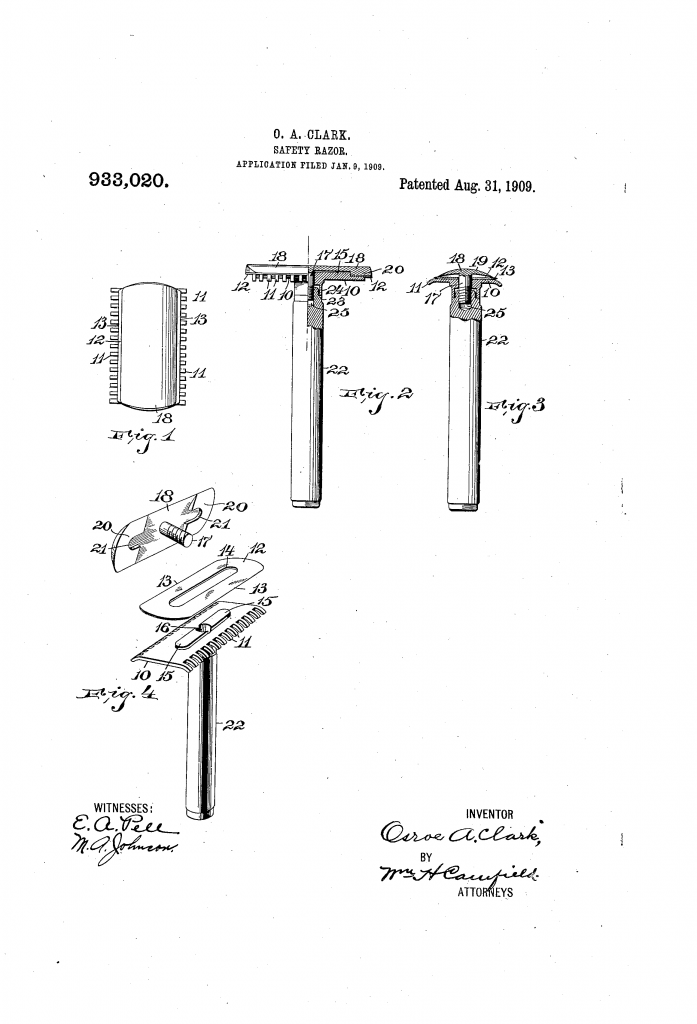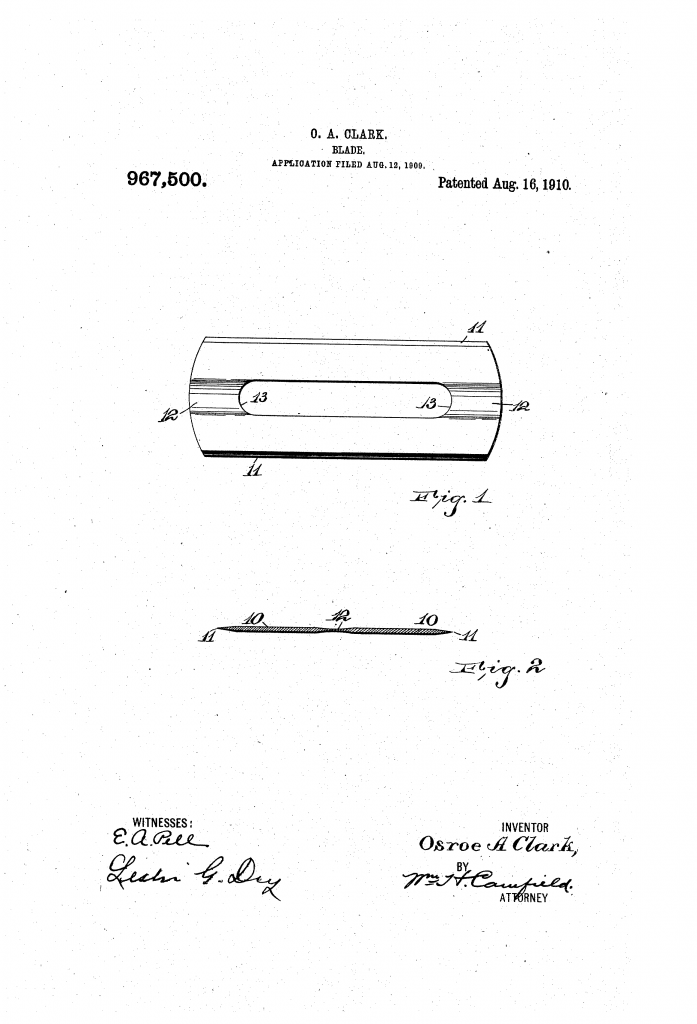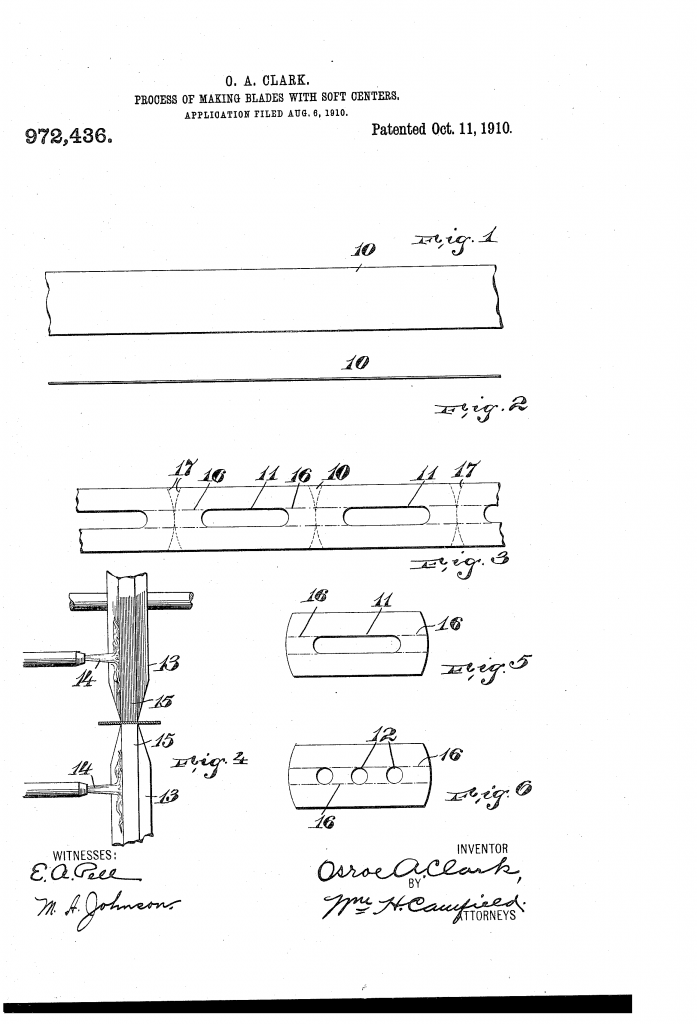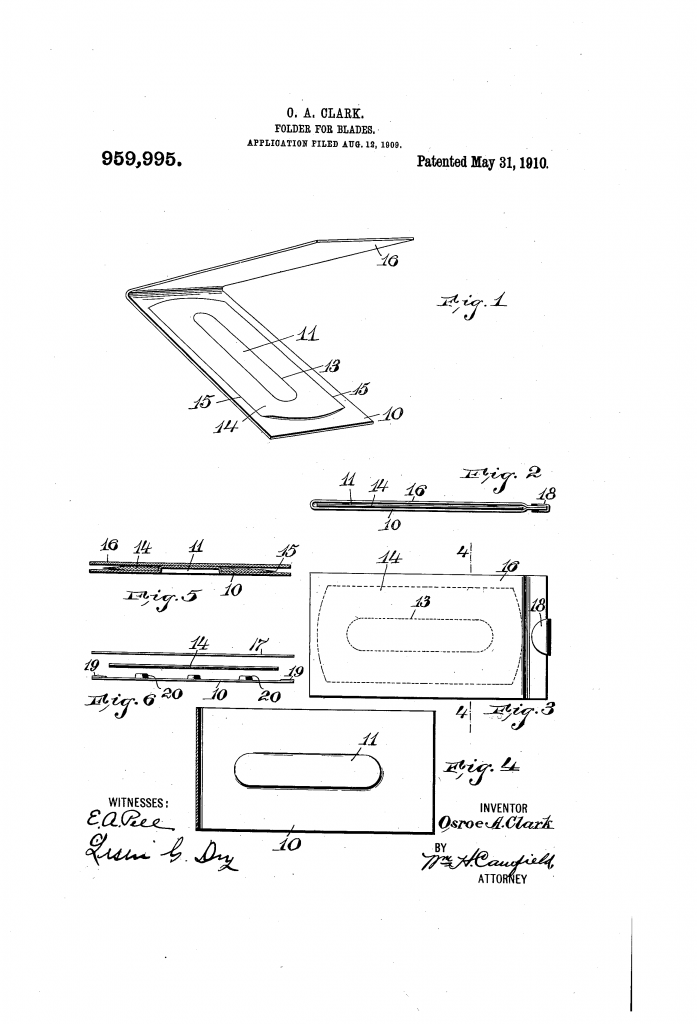Early in 1909 Mr O A Clark filed a patent for a razor that looks remarkable modern. A little too modern for the time perhaps… it used a slotted blade, something that didn’t catch on until the 30’s. But Mr Clark didn’t stop by patenting a razor. He also patented the blade by itself, which had some neat features. He patented a way to pack and dispense the blades neatly. And he patented the way to manufacture his special blades. In short, Osroe A Clark dreamt up and patented a whole shaving system. Which seems to have sunk without much of a trace… shame, really.
The razor
Seen from today, the razor was nothing spectacular. Seen from 1909, it a harbinger of the future.

The razor was a simple three piece device. It consisted of a top cap, a bottom plate, and a handle. The top cap had a central post with screw threads. The handle had a hole on top with matching threads. When assembled, the handle and top cap sandwiched the blade and bottom plate between them. So far the same as any other three piece razor, such as the Gillette Old.
What made the razor special – at least compared to the then new Gillette Old – was the lack of two pins on the top cap and matching holes in the bottom plate. Instead the Clark razor had a raised bar1 on the bottom plate and matching recesses2 in the top cap. The bar lined up with the oblong hole in the blade, securely positioning it in the razor. Or as the patent text says:
The invention is particularly designed to provide co-acting means on the guard and on the face plate to hold the face plate and the backing in register and to position them when they are assembled, and also to provide the blade with a perforation to permit the assembling of the parts through the blade and to also permit the blade to surround the positioning means or the co-acting means for holding the guard and the face plate in register so that the blade is also held in its proper position with its edges in parallel relation with the edges of the guard.
From US patent 933,020
Clear as mud, as patent texts often are. But in short the raised bar holds both blade and cap in the right position – just like the pins and holes did for the Gillette Old.
Blade and blade manufacture
While a shaver might consider the razor the primary thing, for a shaving system the blade is really the heart of it all. No blade, no system. And while Osroe A Clark did describe the blade in detail in his patent on the razor, he did patent an improved blade and the means of making it a few months after filing the razor patent.
The problem with a slotted blade, as Mr Clark no doubt realised early on, is that there is less material keeping the two edged attached to each other. And if the blade is brittle… it will snap when bent. As the patent puts it:
When so bent, blades have been known to break frequently, and the loss on this account is considerable. The blades are of hard metal and are brittle, the greatest strain coming about at the longitudinal center of the blade where the contraction on one surface and the tension on the opposite surface is greatest.
From US patent 967,500
And the solution? Make the middle of the blade softer or more flexible. The same concept as we find in other inventions, such as the one patented by Georg Friedrich Hofmann at roughly the same time. But while Hofman envisioned a built up blade consisting of multiple part, Clark simply made the unitary blade more bendy in the middle.

Clark achieved this by grinding the centre of the blade thinner. As the stiffness of a plate is governed mainly by the thickness, reducing the thickness makes it more bendy.
In his patent on razor blade manufacture, Mr Clark showed another way of achieving a more bendy middle. This was by heat treating the middle of the blade, since annealed steel is softer than hardened steel. The annealing was to be done with two heated rollers3, between which the steel strip would pass.

It is clear from the patent that Mr Clark planed to use thicker sheets of steel than you would commonly find4 in razor blades. Or as the patent text states:
My invention enables me to utilize steel of considerable thickness when compared to a wafer blade, and permits the steel, when it is annealed, to be bent so that when it is formed into a razor blade, even in view of its thickness, it readily conforms to any frame in which it is flexed.
From US patent 972,436
The thicker blades, Clark claims, would not only be sturdier but also hold their edge for longer.
Interestingly the patent also shows an alternative form of the blade, clearly meant to fit a Gillette Old type razor. This raises the interesting possibility that Clarks slotted blade may be dimensionally interchangeable with a Gillette Three Hole blade. All that would be required would be that the outer edge of the slot would fit around the pins of a Gillette Old.
Packaging the blade
Once a blade was manufactured, be it with a ground or annealed centre portion, it needed to make its way to the shaver’s razor. As other manufacturers have known, as exemplified by Kaufman’s new and useful improvements in safety razor blade packaging, it is important to wrap the blade securely – and cheaply. We are, after all, talking about blades in large volumes.
Mr Clark came up with a blade folder for his shaving system that not only held the blade safely, but also prevented the edge from coming in contact with any foreign element. This included the wrapper itself.
This was done by utilising the slot in the blade itself. The packaging included raised portions, made either by laminating several sheets of material,5 or by embossing. The raised portion would prevent the blade from sliding around, until the user broke the seal and raised the top flap up.

The patent also states that it is possible to transfer the blade to the razor without touching it, although I have trouble seeing how that could be done.
Thoughts on the 1909 shaving system
Overall the four patents seen as a whole represents a full shaving system. Much in the same way a cartridge razor does today, there is a clear line from blade, via packaging, to the razor. It is just a shame it seem to have disappeared quickly. According to Waits’ Compendium, it was briefly manufactured under the brand “Clark’s Winner” by Clark Blade and Razor Co.6, in the time period 1909-1911.
The whole thing was well though out, and look at least as streamlined as Gillette’s offering at the same time. I suspect that being later to marked was part of the downfall of the system.
The patents are obviously expired. The method to align the top cap to the blade and bottom plate would work with todays slotted blades too. For all I know some razor may already use it.
Osroe A Clark also have other razor patents to his name. These include a four edged razor, a single edge, and a shavette. You can read the full patents for his 1909 safety razor, blade, blade manufacture, and blade packaging on Google Patents.
Footnotes:
- Marked 15 on the patent drawings.
- Marked as 21 on the drawings.
- I have to wonder about what material Clark envisioned making these rollers from, since the annealing temperature of carbon steel is around 750°C (1320°F)…
- And back in the early days of safety razors, blades were thicker than they are today.
- Paper, cardstock, or even sheet metal.
- Who also manufactured the Clark’s Nox-all, which courts considered an infringement on Gillette’s patents.

Pingback: A simple and neat 1909 shaving system - Razors n Blades the shave that saves
Pingback: The shavette system of Edward Weck - Wegian WetshavingWegian Wetshaving